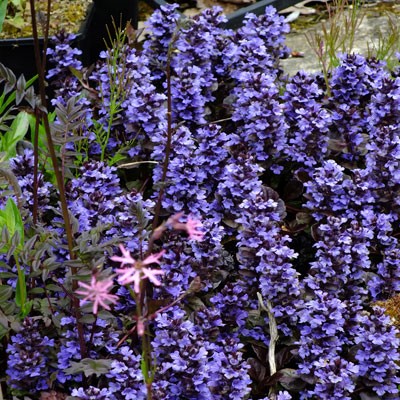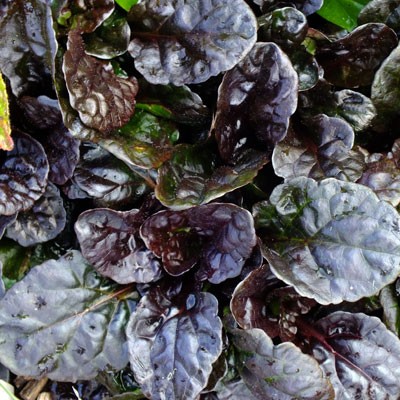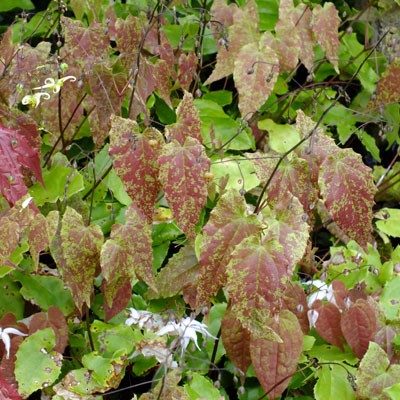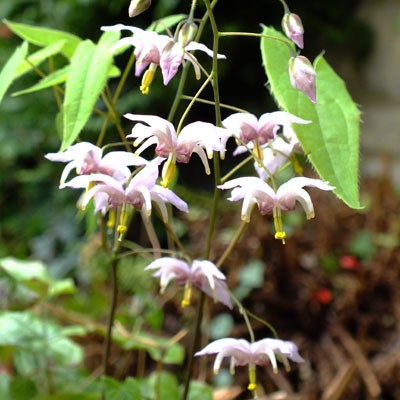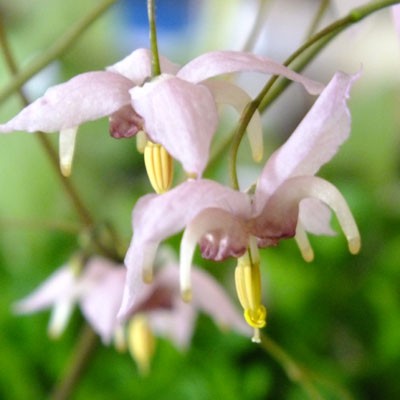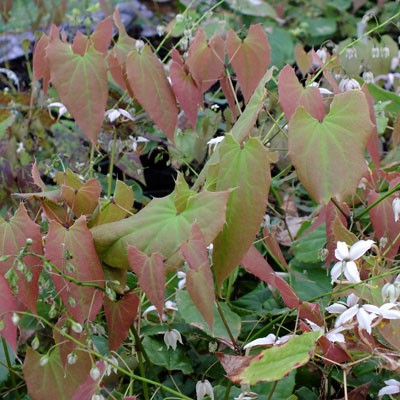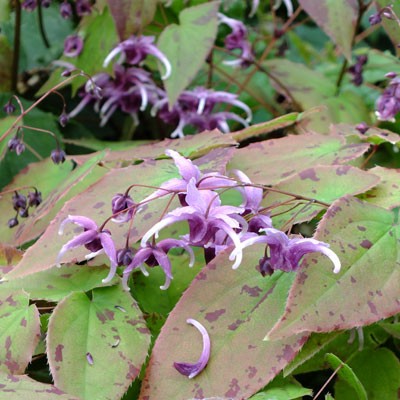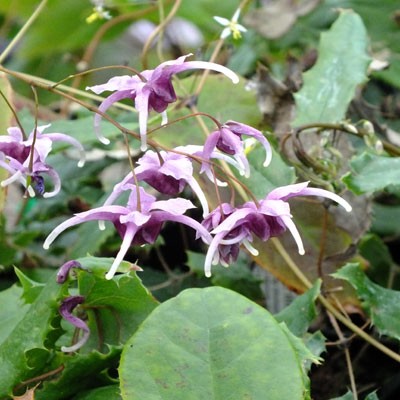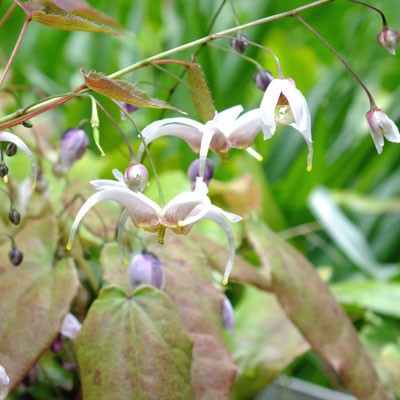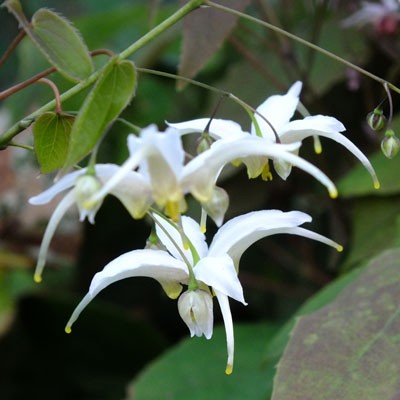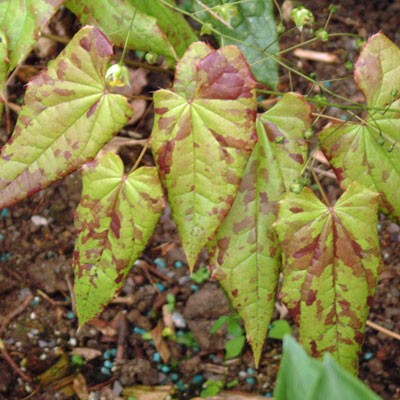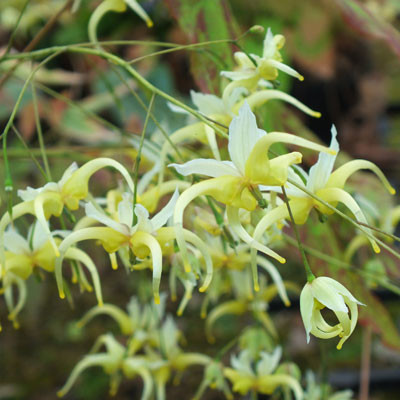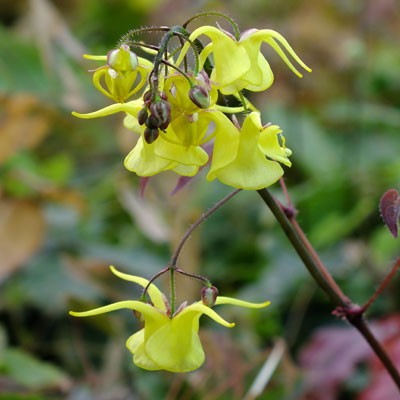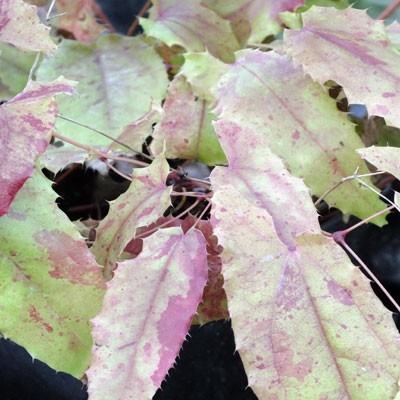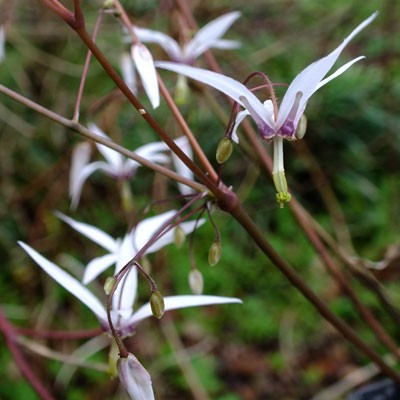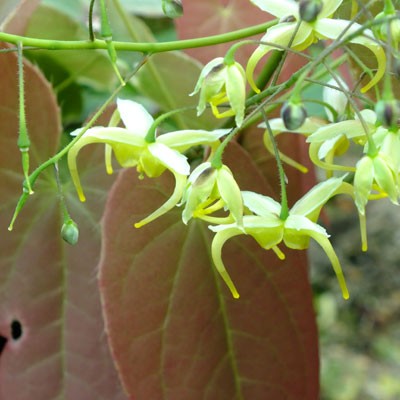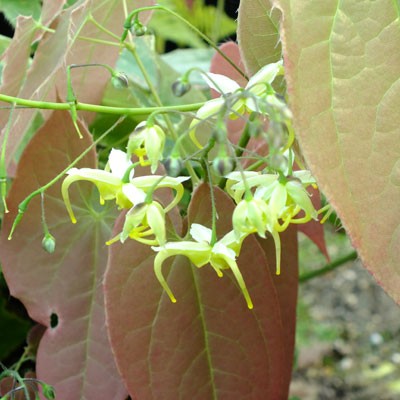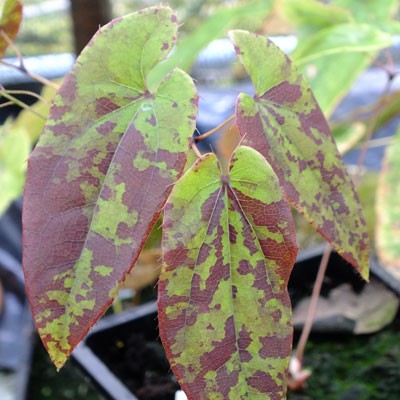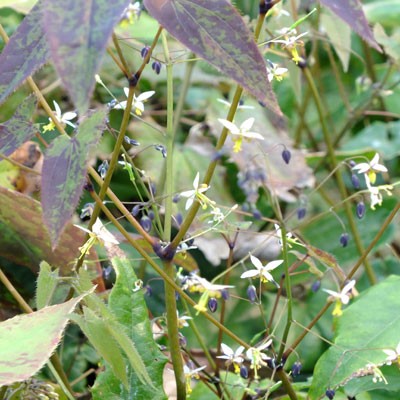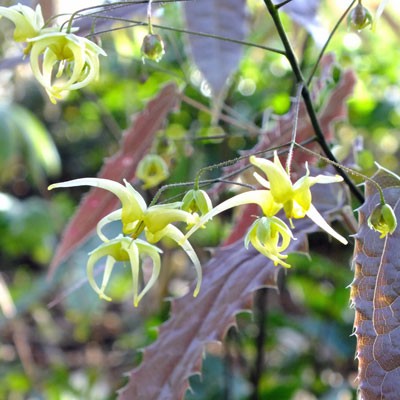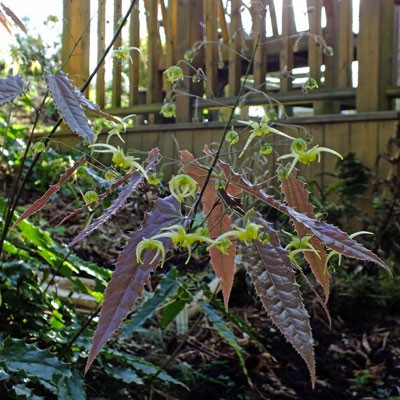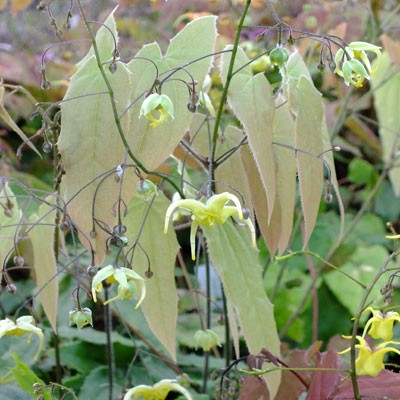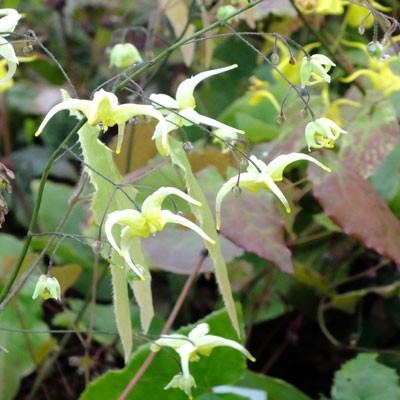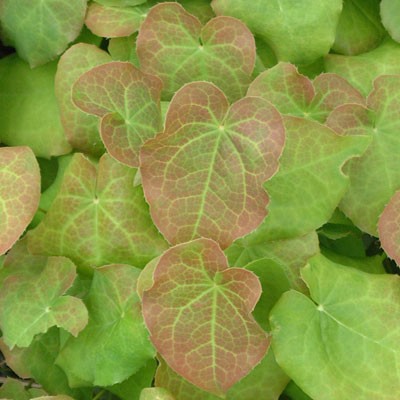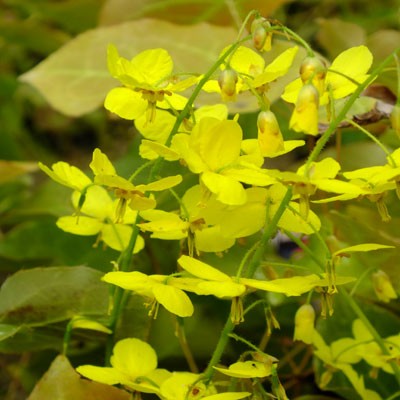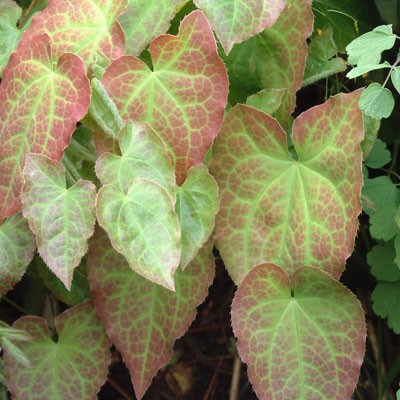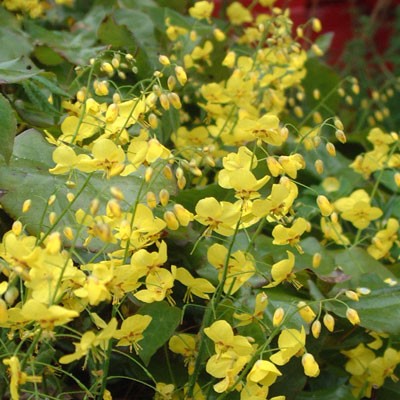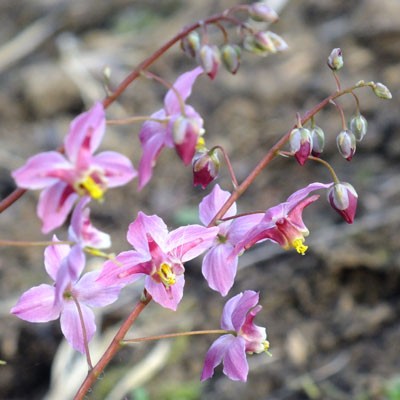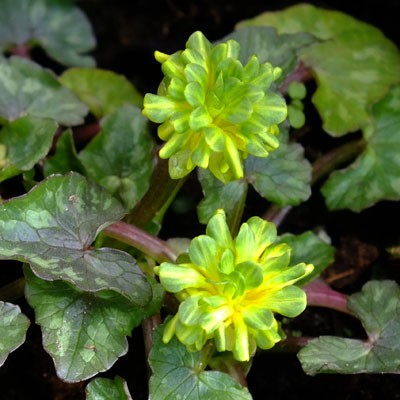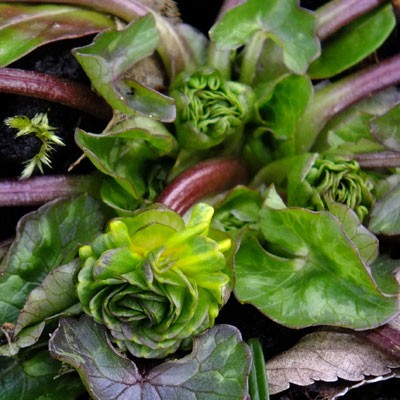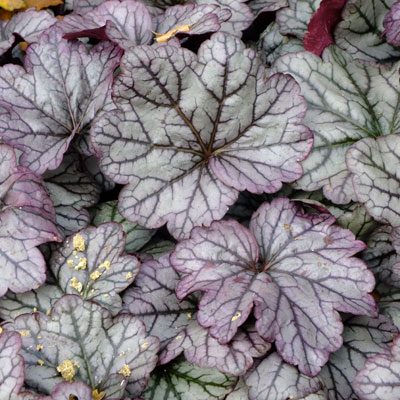-
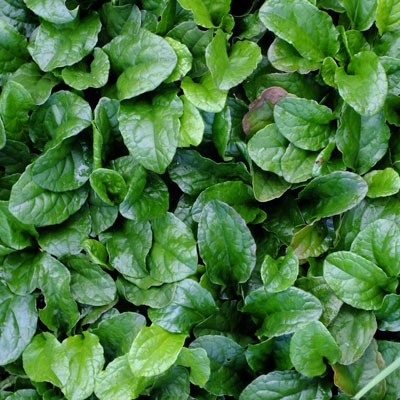

Potsize - 1L
Bugle. Lovely ground cover for a shady spot where the green leaves will make a dense carpet above which will stand dense, short spikes of pink flowers in the spring. Discount of 25p per plant for quantities of 3 or overLinks
Botanical Style Photographs
-
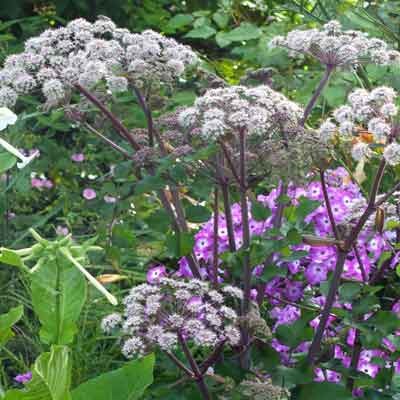
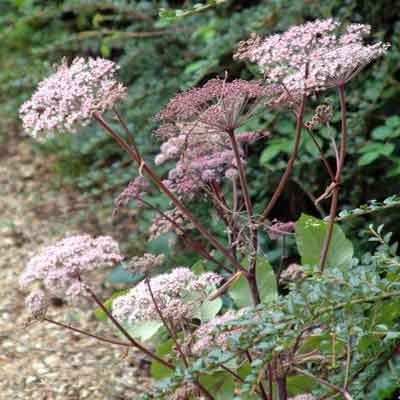

Bee Friendly
Potsize - 1L
Angelica sylvestris 'Purpurea' . Starting remarkably early in the year this plant pushes up fascinating glossy purple foliage, soon becoming an imposing architectural feature topped with a dense spherical head of pink flowers. In appearance not dissimilar to a more sturdy cow parsley, but with less air and more presence. Will seed about mildly. Likes a good moist spot. Discount of 25p per plant for quantities of 3 or overLinks
Umbellifers
-
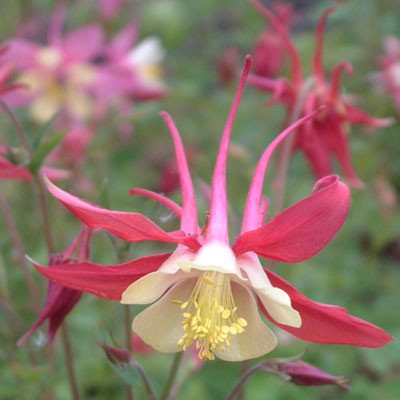
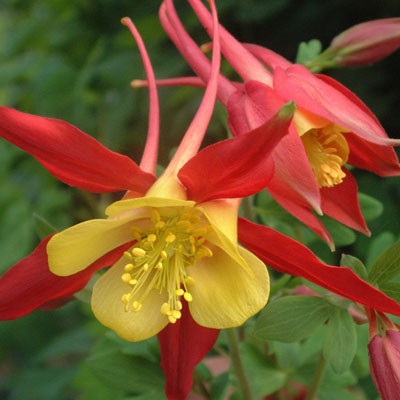
Potsize - 9cm
Aquilegia 'Koralle' An old cottage garden favourite and a good cut flower. Abundant display in late spring of long spurred red and yellow flowers over fine blue-green foliage. 80cm. Full sun. Medium height variety. A seed grown strain that might display some variation in colour and form. HARMFUL IF EATENDiscount of 25p per plant for quantities of 3 or more of this variety, 50p for 10 of any AquilegiaLinks
Aquilegia Compared
-

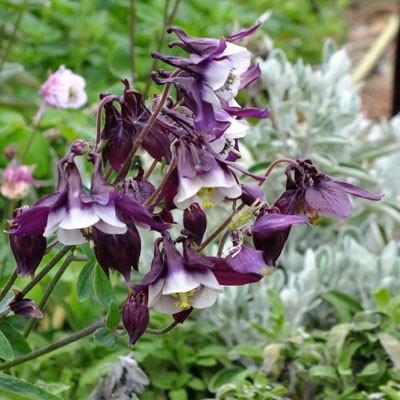
Potsize - 9cm
Aquilegia vulgaris 'William Guiness' ('Magpie') A recent introduction with striking flowers in bicolour white and deep purple (near black). The flowers are of traditional nodding A. vulgaris form with well flared petals and curve-tipped spurs. Would look good in a mixed cottagey border Best in light shade. 90cm HARMFUL IF EATENDiscount of 25p per plant for quantities of 3 or more of this variety, 50p for 10 of any AquilegiaLinks
Aquilegia Compared
-
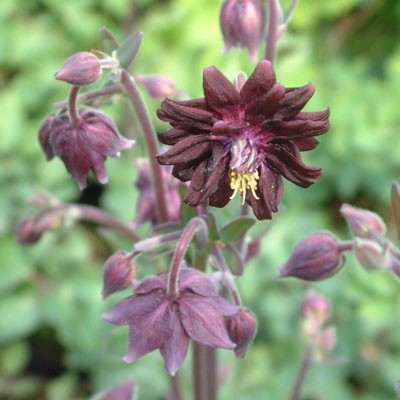
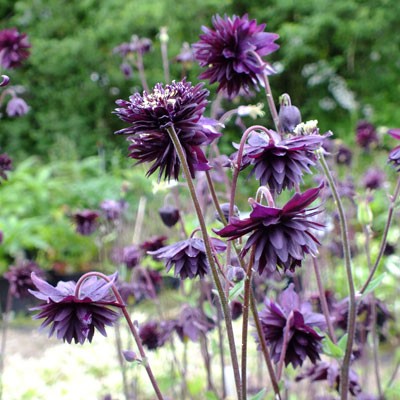
Potsize - 9cm
Aquilegia vulgaris var. stellata 'Black Barlow' (Barlow Series). One of the spur-less Barlow series based around the plant originally found in the garden of Nora Barlow. This form has flowers that are a deep dusky maroon. Would look good in a mixed cottagey border, hanging above paler mounds of flowers. Best in light shade. HARMFUL IF EATENDiscount of 25p per plant for quantities of 3 or more of this variety, 50p for 10 of any AquilegiaLinks
Aquilegia Compared
-
Sale!
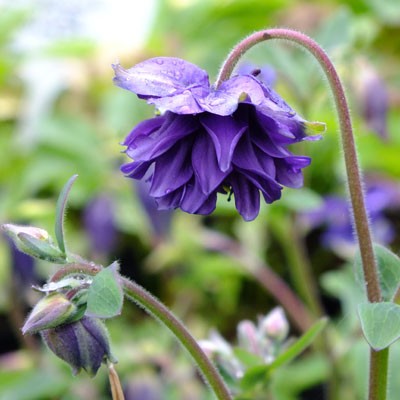
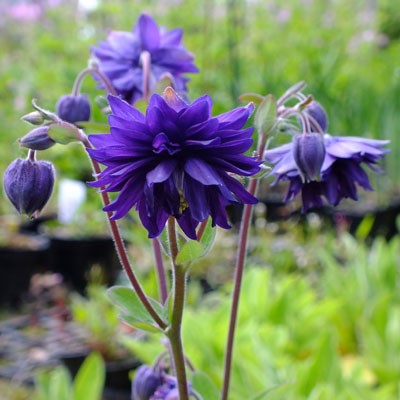
Potsize - 9cm
One of the spur-less Barlow series based around the plant originally found in the garden of Nora Barlow. This form has flowers that are a violet-blue. Would look good in a mixed cottagey border, hanging above paler mounds of flowers. Best in light shade. HARMFUL IF EATENDiscount of 25p per plant for quantities of 3 or more of this variety, 50p for 10 of any AquilegiaLinks
Aquilegia Compared
-

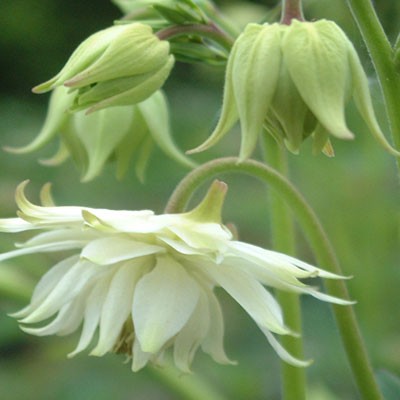
Potsize - 9cm
A beautiful form of Aquilegia clematiflora with exquisitely shaped, completely spurless flowers reminiscent of its name-sake. The flowers are shaded green in bud and retain green tips when open pure white. The leaves are fresh apple-green and erupt as early as February making a lovely foil for Spring flowers. 60cmDiscount of 25p per plant for quantities of 3 or more of this variety, 50p for 10 of any AquilegiaLinks
Aquilegia Compared
-

Potsize - 9cm
A fitting name for this richly claret coloured, very double. Spurless Aquilegia. A tall elegant variety with strong stems. 60-90cmDiscount of 25p per plant for quantities of 3 or more of this variety, 50p for 10 of any AquilegiaLinks
Aquilegia Compared
-
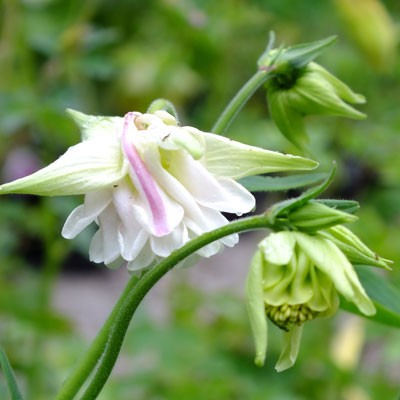
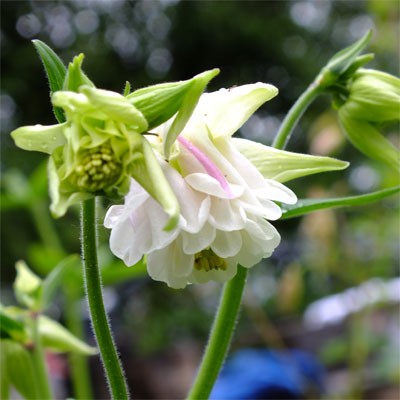
Potsize - 9cm
One of the spur-less Barlow series based around the plant originally found in the garden of Nora Barlow. This form has flowers that are a fully double, white with green tips. Would look good in a mixed cottagey border, hanging above paler mounds of flowers. 80cm. May-July. Best in light shade. HARMFUL IF EATENDiscount of 25p per plant for quantities of 3 or more of this variety, 50p for 10 of any AquilegiaLinks
Aquilegia Compared
-
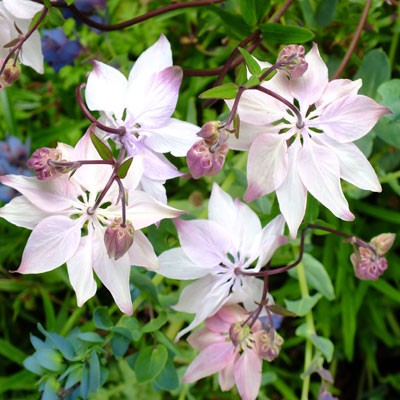

Potsize - 9cm
Aquilegia vulgaris var. stellata ( A. clematidiflora ). A variation on an old cottage garden classic. This is the root of all of those double flowered forms that you find under the 'Barlow' banner. It is a lovely thing, having quite flat flowers, lacking the usual Aquilegia spurs, and having more than a passing resemblance to a clematis. The stems are tall and all the pale fleshy-pink flowers look down so that you look on the backs of the flowers. easy and well worth squeezing into a mixed bed. Will freely seed about in any well drained soil and cheer any planting in late spring with its wonderful array of pastel flesh pink blooms. Any soil that is not too wet. full sun. 60cmDiscount of 25p per plant for quantities of 3 or more of this variety, 50p for 10 of any AquilegiaLinks
Aquilegia Compared
-

Potsize - 9cm
Aquilegia 'White Star' (Star Series) ( syn. 'Kristal', 'Crystal Star'). A long spurred aquilegia with pure white flowers. A cottage garden favourite and an excellent and unusual cut flower. The flowers posses such a clean crisp bright whiteness that is only matched by flowers such as Geranium sylvaticum 'Album' - it's a wonder they haven't found their way onto Persil adverts. May to June. 85cm. Sun. HARMFUL IF EATENDiscount of 25p per plant for quantities of 3 or more of this variety, 50p for 10 of any AquilegiaLinks
Aquilegia Compared
-
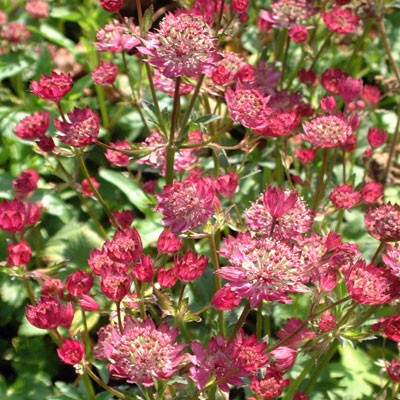
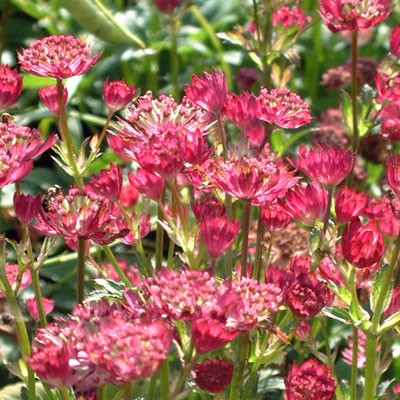
Potsize - 1L
A recently selected large flowered dark red masterwort. Tight clusters of maroon flowers are surrounded by beautiful ray florets. An interesting & beautiful plant happy in sun or part shade with some drainageLinks
Astrantia Compared
Astrantia in the Garden
Botanical Style Photographs
-
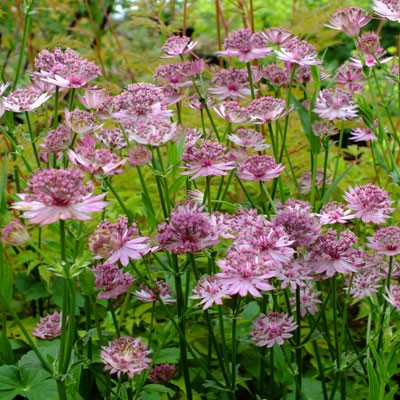
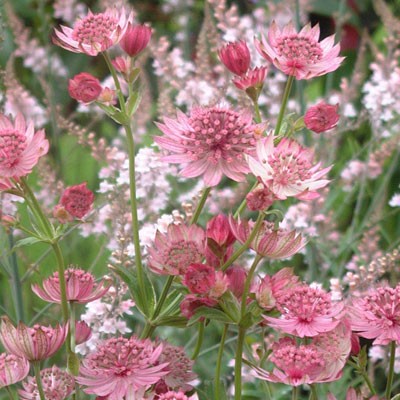
Potsize - 1L
Astrantia 'Roma'. Lovely mid pink cultivar of good constitution. The bracts form a shallow starry cup that is a shade lighter than the tight central pincushion of true flowers. 60cm. An interesting & beautiful plant Happy in sun or part shade with some drainageLinks
Astrantia Compared
Astrantia in the Garden
Botanical Style Photographs
-

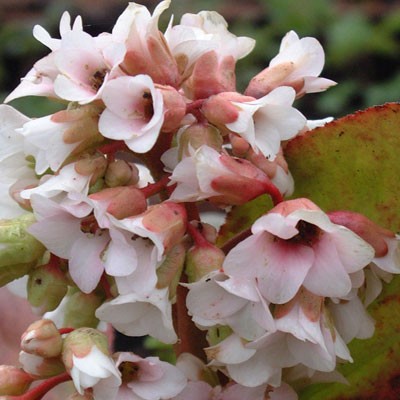
Potsize - 1L
Bergenia 'Bressingham White'. Praised for its robust stature and the freedom with which it produces both flower and leaf. Slowly spreading to form a good clump of large leaves with fine trusses of pure white flowers from March until May. Raised by Blooms and happy in both sun and part shade.Discount of 25p per plant for quantities of 3 or overLinks
Bergenia Compared
Botanical Style Photographs
-
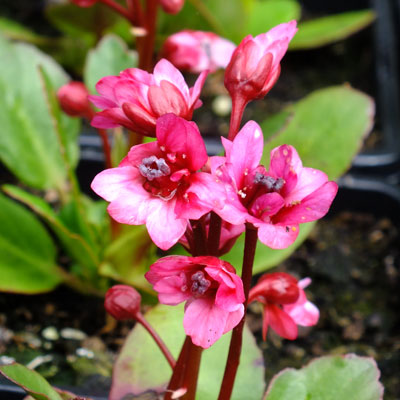

Potsize - 1L
This is a compact form of Bergenia but one that punches above its weight when it comes to flowering. Flowers are bright rosy-pink, carried on bright red stems and produced abundantly in March and April. Foliage is green for the growing season and turns deep beetroot in the Winter. 15-30cm tall. Discount of 25p per plant for quantities of 3 or overLinks
Bergenia Compared
Botanical Style Photographs
-
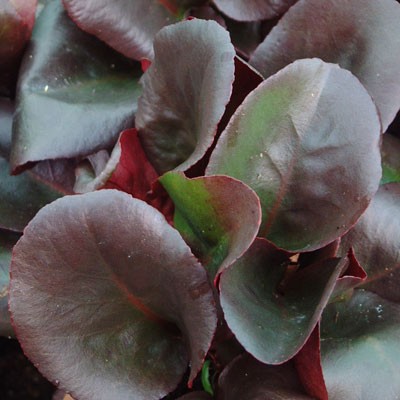
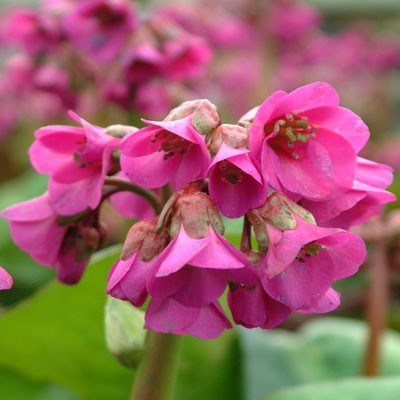
Potsize - 1L
Bergenia 'Overture' ('Eroica'). Handsome evergreen glossy green leaves are overlaid in Autumn onwards with shades of red and copper and can turn bright scarlet on exposed sun drenched leaves. One of the best for reliable winter leaf colour. The flowers are brightest magenta, produced from early to late spring. 30cm. Clumps are fairly compact in growth with flower spikes that are also relatively dense. Will even tolerate dry shade. Discount of 25p per plant for quantities of 3 or overLinks
Bergenia Compared
Botanical Style Photographs
-
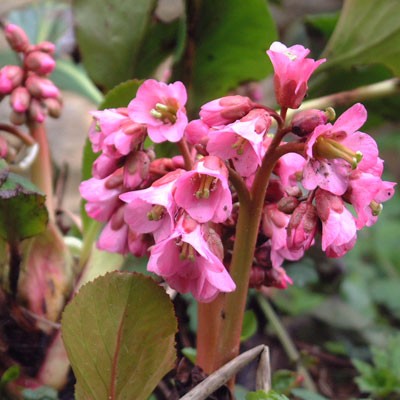
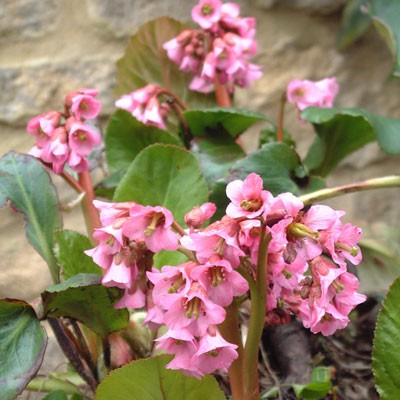
Potsize - 1L
Bergenia 'Silberlicht'. A relatively new addition to the Bergenia family having been raised in 1982 by H.Klose. It thrives in sun or shade even in quite dry conditions and produces valuable ground cover of handsome bronze tinted leaves. Its real beauty is shown when in flower late in the Spring. Flowering stems are tall and pink carrying flowers in a sugar pink hue. Discount of 25p per plant for quantities of 3 or overLinks
Bergenia Compared
Botanical Style Photographs
-
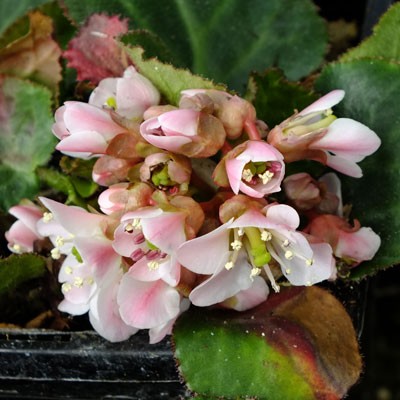
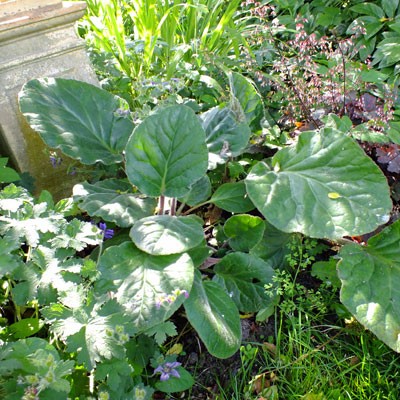
Potsize - 1L
Bergenia ciliata. The leaves of this choice species are large- up to 30cm across, well rounded and covered in tiny hairs. It makes a large clump, but considerably less dense than most bergenias. The flowers are pink, held erect and slightly fragrant. Slightly more tender than the more robust species and deserving of a spot with some shelter, especially for the flowers. Foliage will die back somewhat in winter. Leaves colour red in Autumn. Native of Afghanistan and Tibet. Prefers cool moist shade.Links
Bergenia Compared
Botanical Style Photographs
-
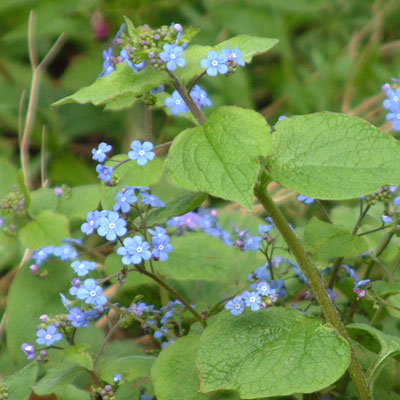
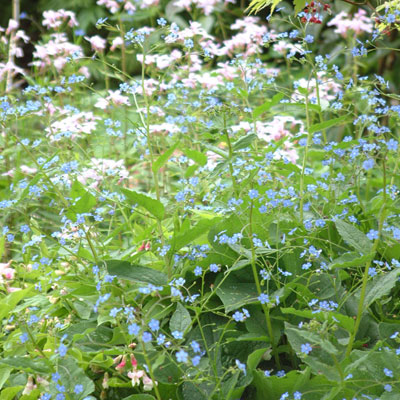
Potsize - 1L
Siberian Bugloss. A brilliant perennial which grows well in dry shady places, but will excel in most reasonable positions. Large heart-shaped felty green leaves make a stout clump topped in Spring with a cloud of tiny forget-me-not flowers. Hardy and reliable and one of those plants that ought to find a place in every garden. 30-45cmDiscount of 25p per plant for quantities of 3 or overLinks
Brunnera Compared
Botanical Style Photographs
-
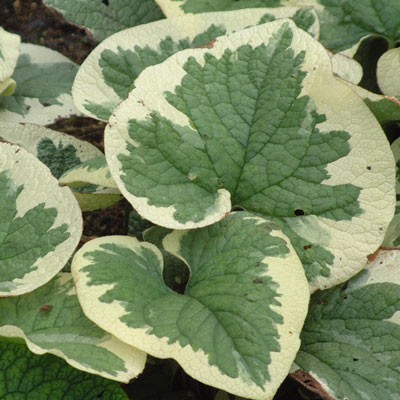
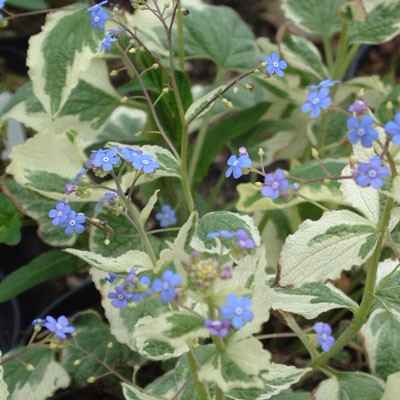
Potsize - 1L
Beautiful leaf form with large heart shaped leaves boldly bordered in white. A delicate cloud of pale blue forget-me-not flowers brings the whole plant to life in spring. Grows best in light shade and needs to be sited away from full sun where the leaves can sometimes scorch. 60cm This variety was brought to cultivation from a garden in Holland some time before 1969 by Douglas Dawson. The variegation is bolder, white rather than yellow, and the whole plant more compact than Brunnera 'Hadspen Cream'.Links
Brunnera Compared
Botanical Style Photographs
-
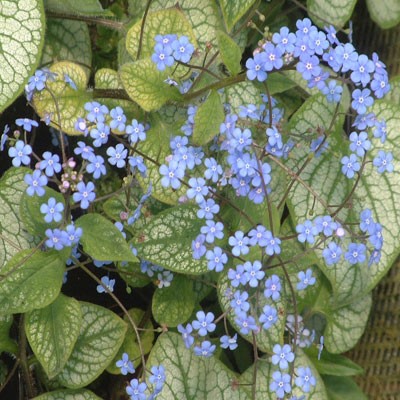
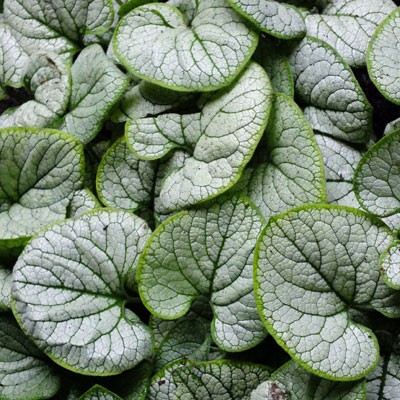
Potsize - 1L
Brunnera macrophylla 'Silver Heart'. A new introduction (2012) by Spilsbergen-Willemsen from the Netherlands. Superficially like a more silvered version of the popular Jack Frost, but generally considered to be a tougher more sun resistant variety on account of the thicker character of the leaves, which can also grow larger in size. Coarsely hairy, heart-shaped leaves are heavily silvered and picked out by dark green margins and veins, making fascinating patterns not unlike an intricate cathedral window. A picture from Spring to Autumn especially when given shade and adequate moisture to prevent scorching in high Summer. The Spring display is further enhanced by an airy cloud of icy-blue forget-me-nots on stems decorated with smaller but similarly marked leaves. 50cm plusLinks
Brunnera Compared
Botanical Style Photographs
-
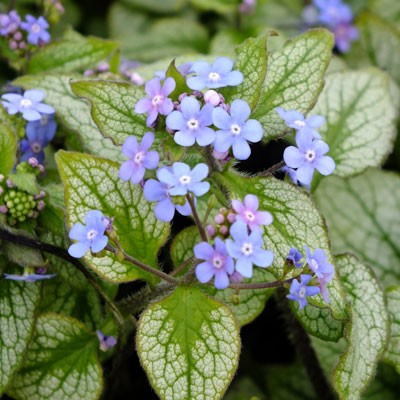
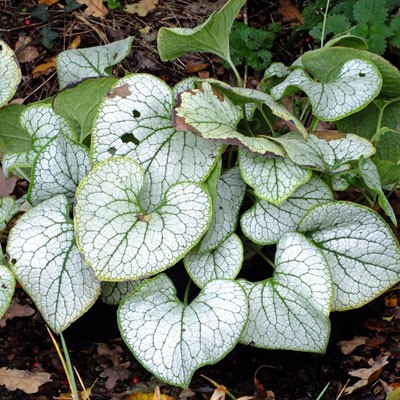
Potsize - 1L
Very similar to the ever popular Brunnera 'Jack Frost' except that it is a little whiter and has an elongated pointed tip to the leaf. Leaves are a lovely silver with the veins picked out in green forming a dense mound in any situation that is out of direct sun. Clouds of blue forget-me-not flowers in Spring.Links
Brunnera Compared
Botanical Style Photographs
-

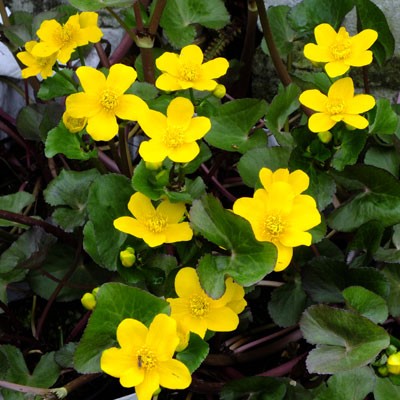

Bee Friendly
Potsize - 1L
A lovely variety with leaves that begin the year a rich bronze in colour. This colour fades as the flower stems develop so that by the time the plant is in full flower the leaves have toned down to a rich dark green with just the flower stems showing a purple flush. However the contrast of dark leaves and shining sunshine yellow flowers as they first emerge from the buds is a most beautiful thing. A variety that deserves to become well known. Marsh Marigolds are amongst the first flowers of Spring, flowering throughout the month of April.Discount of 25p per plant for quantities of 3 or over -
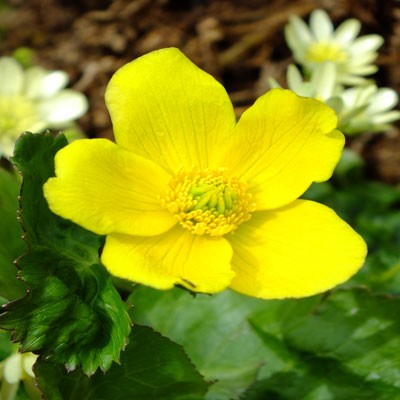
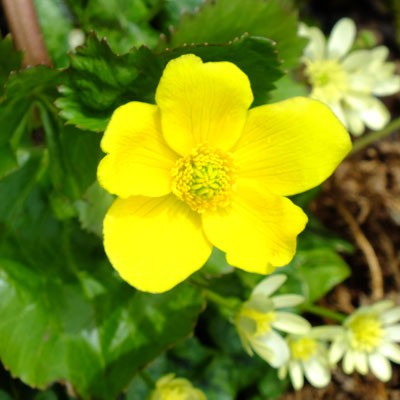

Bee Friendly
Potsize - 1L
There are two factors that set this lovely variety apart, its size and its colouring. It is larger than the species and perhaps a little more upright with leaves that are of a fresher paler green, held on pink stained petioles. The flowers, which are also large, are of a bright lemon yellow rather than the more chrome yellows of most varieties. Will root from the nodes on the flower stems. Can be planted on the pond margin or just into the water. 45cm. Marsh Marigolds are amongst the first flowers of Spring, flowering throughout the month of April. -
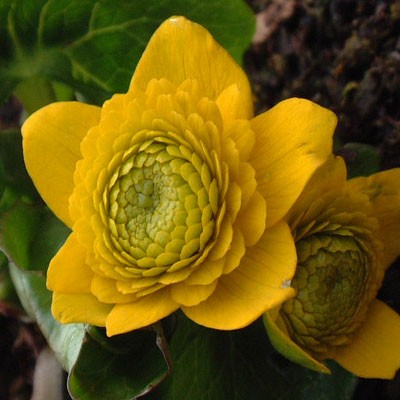
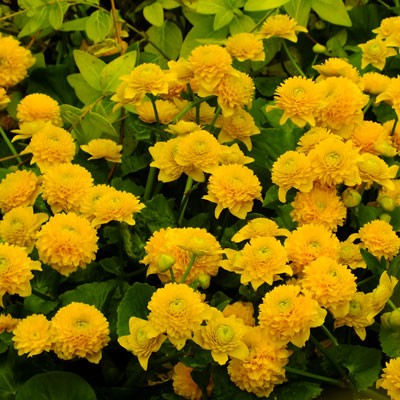

Bee Friendly
Potsize - 1L
As Marsh Marigolds go this one is relatively compact in growth, shorter in all its parts. However it is the flowers that are the chief attraction. They start off looking like a normal Marsh Marigold with the tightest anemone centre you could imagine. Then, as the flowers age, the centre petals grow out until you have a full blown miniature pom-pom dahlia of a flower in rich glowing gold. 30cm spread. Marsh Marigolds are amongst the first flowers of Spring, flowering throughout the month of April.Discount of 25p per plant for quantities of 3 or over -

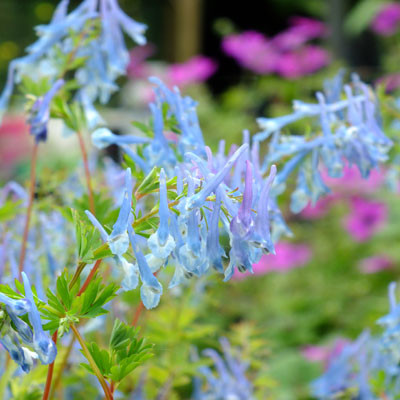
Potsize - 1L
A cross between Corydalis fleuosa and Corydalis omeniana from Ian Young's garden in Aberdeen. Vigorous clumps of limey, chartreusy-green juicy fern-like foliage over which come the strongly scented sky-blue flowers. Like Corydalis elata, but smaller and colouring only very slightly in the stems. Wintergreen and very hardy if grown in a moisture retentive soil which is not over wet and doesn't dry out in the Summer. Divide every three years to maintain vigour and encourage the best flowering. Flowers from Spring until June. 30cmLinks
Corydalis Compared
-
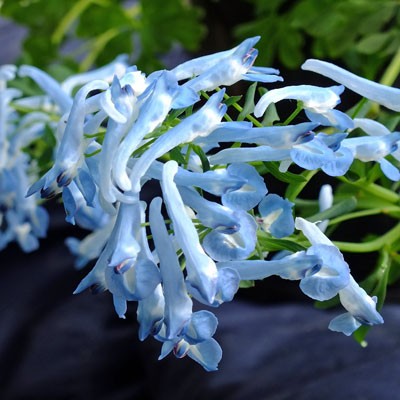

Potsize - 1L
A new repeat flowering variety with intense bright deep turquoise blue flowers that can appear from Early Summer right through until Autumn if moisture remains present. A hybrid of Corydalis flexuosa and Corydalis cashmeriana produced by Keith Lever. Short at 20-30cm. A short variety that retains the compact charm of C.cashmeriana but with a greater degree of vigour. Almost evergreen, taking on good colour in the flower stems with adequate moisture throughout the season.Links
Corydalis Compared
-
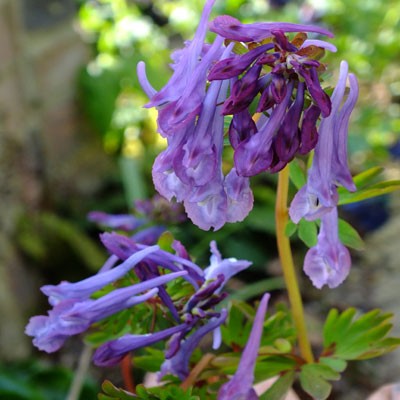

Potsize - 1L
Corydalis 'Spinners'. Distinguished by having flowers that age purple form a blue start earlier in the year. The flowering stems are pretty well upright and carry a distinctive red flush. The foliage mounds up into a ferny bush of fresh appley-green leaves which have a dusky cast in the winter from tiny brown spots. Early Spring. 30*30cm. For moisture retentive soil in shade or half shade. Possibly more evergreen than some.Links
Corydalis Compared
-

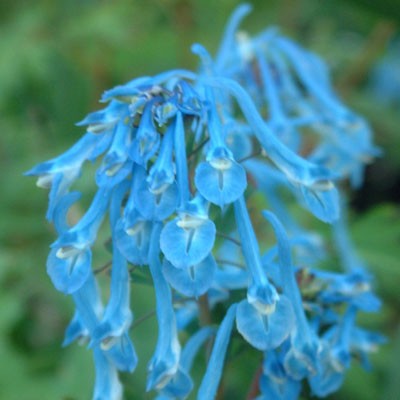
Potsize - 1L
Corydalis 'Tory MP'. This certainly has some Corydalis elata blood in it. The habit is fairly upright with the flowers being held high on tall stems and can come a month later than varieties such as Corydalis flexuosa 'Pere David'. They are a rich blue in colour. I did wonder if this earned its name on account of it being true blue and upstanding, then I read that it came from being true blue and going on and on! - but then again perhaps it owes something to its habit of disappearing from sight over the Summer ! - I'll leave you to draw your own conclusions. Early Spring. 45*30cm. For moisture retentive soil in shade or half shade.Links
Corydalis Compared
-
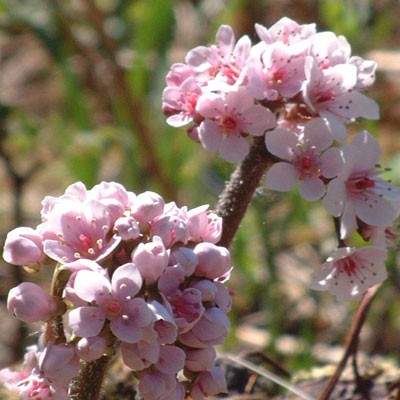
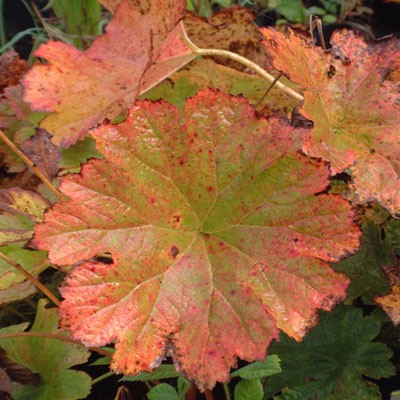
Potsize - 1L
Darmera peltatum (Peltiphyllum peltatum). All through the summer months, the fresh green, broad circular leaves make a bold dense clump before turning lovely scarlet in Autumn. The spring sees large round heads of pink stained flowers rise 3ft high like drumsticks sprouting from the soil. For moist to boggy soil. 125cm tall spreading. Very often planted by the side of a pond, but also suitable for growing in shade, even in light woodland provided there is moisture to be found at the root. The leaves sprout from a network of thick rhizomes that creep over the top of the soil in a dense mat. Discount of 25p per plant for quantities of 3 or over -



RHS AGM
Potsize - 1L
The beautiful Bleeding Heart or Lady-in-the-Bath. Fresh green ferny foliage above which arch stems dripping pink & white flowers like dewdrops. A picture of poise and grace. 3ft in a nice moist soil. The fleshy roots are delving and brittle so its best not disturbed and best sited in a sheltered situation in sun or partial shade with plenty of humus. In hot situations where water might go short at the roots, the plant will take a period of Summer dormancy but will re-emerge the following Spring. Mulching helps to extend the flowering season. Great cut flower and surprisingly scented. Deer and Rabbit resistant, possibly on account of its yellow sap. You know a plant has been loved for years when it has numerous names. For this one try Bleeding Hearts or Ladies-in-the-Bath, Ladies-in-a-boat or Dutchman's Breeches or even Lady's Locket and Lyre Flower. The ladies-in-the-bath/boat reference is only apparent if you take an open flower, turn it upside down and pull the outer petals apart, then it becomes obvious. Discount of 25p per plant for quantities of 3 or overLinks
Botanical Style Photographs
-
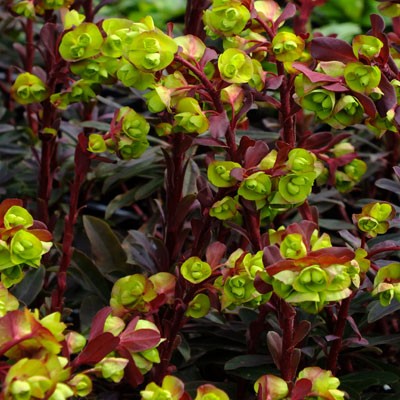
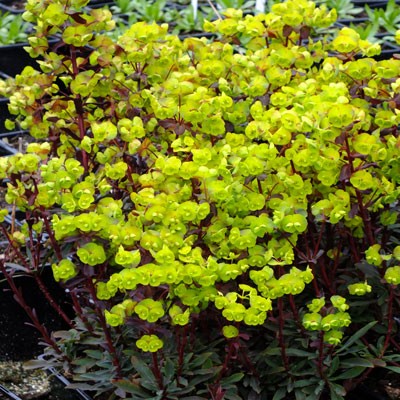
Potsize - 1L
Year round interest from rich deep maroon evergreen foliage with lighter burgundy new growth Topped in spring with bright yellow/green flws. HARMFUL IF EATEN. SKIN/EYE IRRITANTLinks
Euphorbia in the Garden
Botanical Style Photographs
-

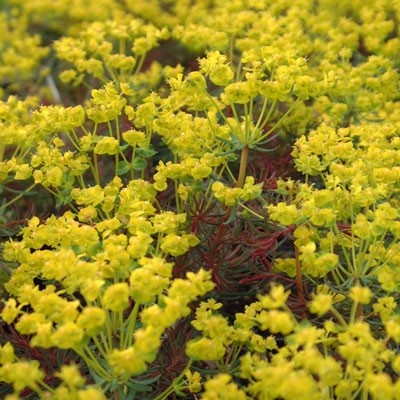
Potsize - 1L
Euphorbia cyparissias 'Red Devil'. Pretty little Euphorbia with deep red new growth which fades a deep sea green, the perfect foil for the bright acid yellow flowers produced in profusion in spring. It's only 20cm tall but a great assest anywhere. The fine thread-like foliage is lovely in its own respect, but the brightness of the flowers punch well above their weight and persist for so long, fading into rich autumn tones before they depart. Any soil. Will run. HARMFUL IF EATEN. SKIN/EYE IRRITANTDiscount of 25p per plant for quantities of 3 or overLinks
Euphorbia in the Garden
Botanical Style Photographs
-
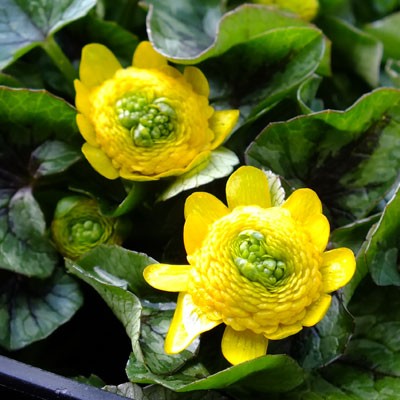

Potsize - 9cm
An anemone centred celandine . Bright golden yellow with widely spaced rounded petals around a tight central boss of curved petaloid stamens. The leaves are a joy for they are variously marbled and splashed with green, black and pewter. Sterile. Probably selected at Myddleton House, the garden of EA Bowles. Propagated by P Corbis in Yelverton in the 1960's as Beamish Double -
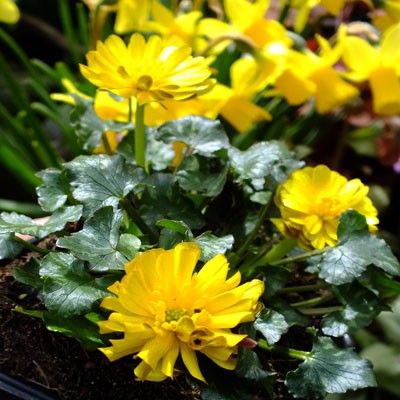
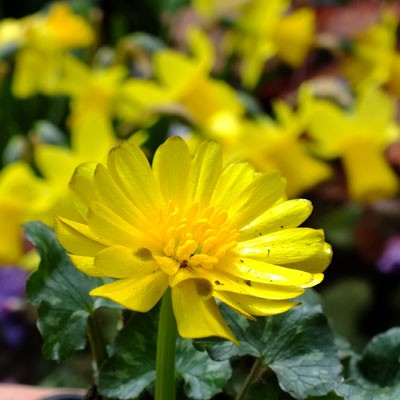
Potsize - 9cm
Lesser Celandine. Gold-edged, bronze buds open to a typical celandine colour, the difference being that Ficaria verna 'Montacute' (Ranunculus ficaria) has 4 ruffs of petals, prettily incurved to reveal the contrasting bronzy reverse. The petals are neatly square-ended, almost as if they have been trimmed. Unlike 'Flore Pleno' the centres of the flowers are open revealing a green eye surrounded by a boss of orange anthers. The leaves are arrow shaped, green flecked with silver. A favourite of mine and one of the earliest to flower. Said to have been rescued from a verge in Montacute, Somerset in 1994 just prior to being destroyed in roadworks. -
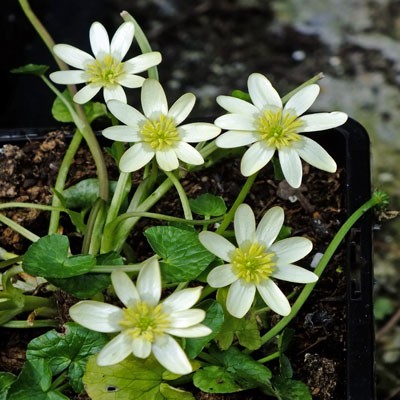
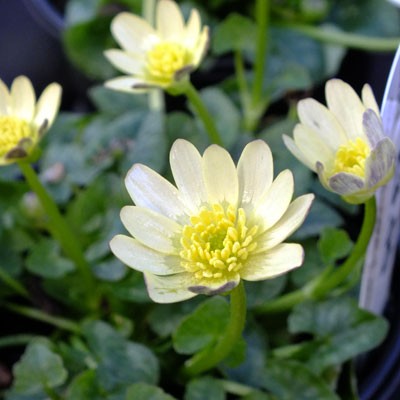
Potsize - 9cm
Lesser Celandine. Glossy Buttermilk petals, shaded purplish on the reverse set off by a central boss of double-cream stamens. A nice contrast to the other cultivars or where the bold yellows are a bit too strident. Plain green leaves. This selection comes from Allan Robinson, former Rock Garden Superintendent at Wisley, who named it after his cat. -
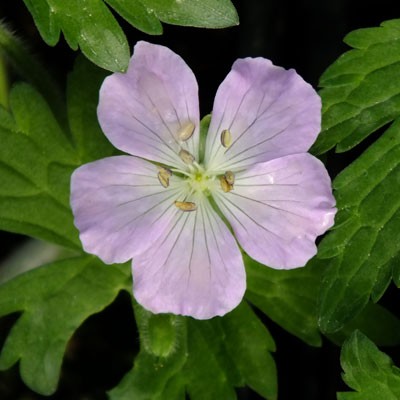
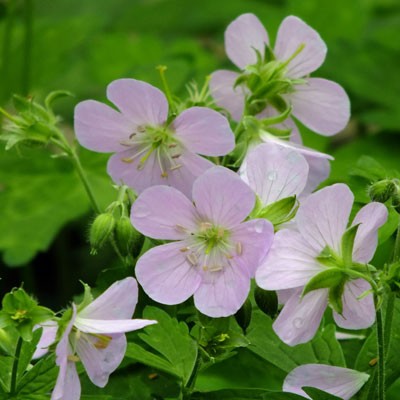
Potsize - 1L
Geranium maculatum 'Beth Chatto'. G.'Chatto' is distinguished by the most lovely clear, pale sugar pink flowers that it shows off to great effect in outward facing clusters above the pale green foliage. Larger and more deeply coloured than ‘Shameface’. Geranium maculatum is a variable moisture loving species; the best of the North American species. Flowers appear April to June (and often again in Autumn) with clusters of upward facing flowers well above the deeply cut leaves. Best in damp shadeDiscount of 25p per plant for quantities of 3 or overLinks
Geranium Compared
Geranium in the Garden
Botanical Style Photographs
-


Potsize - 1L
Geranium maculatum 'Espresso'. Impressive leaves which are deeply fingered and coloured brown, a colour which lasts well into the Summer. Flowers are produced early and are pale pink. The whole plant is a little smaller than ‘Elizabeth Ann’. Geranium maculatum is a variable moisture loving species; the best of the North American species. Flowers appear April to June (and often again in Autumn) with clusters of upward facing flowers well above the deeply cut leaves. Best in damp shade, but needs some sun to develop the leaf colour . Raised by Dale Hendricks of North Creek Nurseries, USA. Discount of 25p per plant for quantities of 3 or overLinks
Geranium Compared
Geranium in the Garden
Botanical Style Photographs
-


Pot size - 1L
A really unusual uniquely double flowered phaeum. A showy double row of bright plummy purple petals and in the centre the stamens appear to have been transformed into strange petaloid structures ina alimey-green to fascinating effect. A plant for partial shade wherethe slightly blotched fresh green leaves make an early foil for other spring flowers. Flowering in late April to May to about 75cm. This wonderful find was a chance seedling in the garden of Lynne Edwards in 2013. She named it after her beloved father and lifelong botanical & gardening mentor who had ghiven here her original phaeum. Not so good for insects due to its lack of stamens. fusion_separator style_type="single solid" hide_on_mobile="small-visibility,medium-visibility,large-visibility" class="" id="" sep_color="" top_margin="" bottom_margin="" border_size="" icon="" icon_circle="" icon_circle_color="" width="" alignment="center"][/fusion_separator]Links
Geranium Compared
Geranium in the Garden
Botanical Style Photographs
-
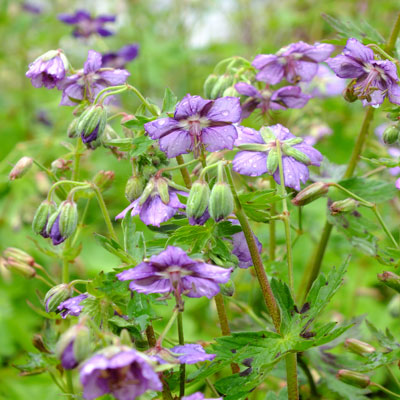
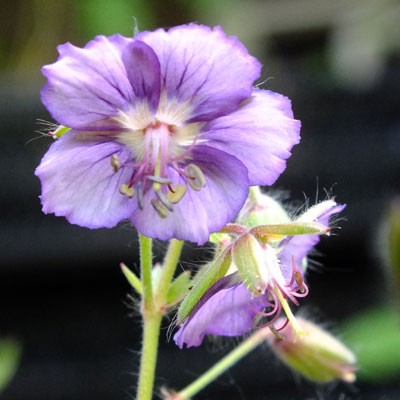
Potsize - 1L
This is one of those plants whose flowers warrant the closest of inspection as they posses the sort of intricate beauty that can easily get overlooked amongst some of their more brash cousins but which nevertheless is as exquisite as they come. Each flower is a translucent lavender-white shaded to the edges and picked out lavender in the veins. Where the petals overlap the colour is stronger and from the white eye protrude a green style and pink anthers. Typical green G.phaeum foliage with small but distinct chocolate spots. Bred by an unknown Dutch gardener. Discount of 25p per plant for quantities of 3 or overLinks
Geranium Compared
Geranium in the Garden
Botanical Style Photographs
-
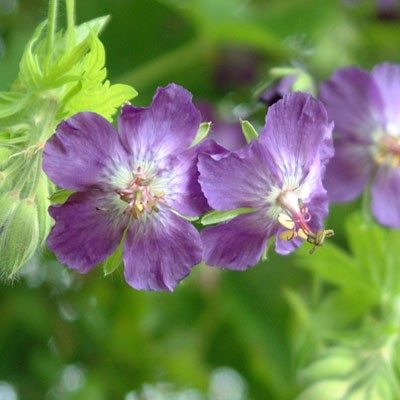
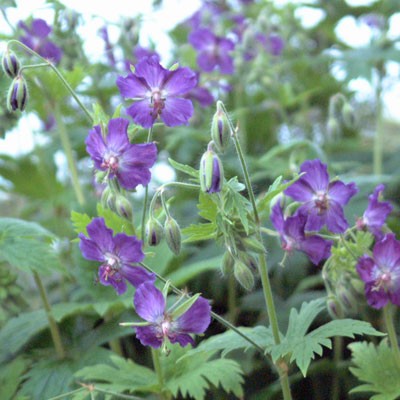
Potsize - 1L
Geranium phaeum 'Lily Lovell'. A striking form of this cranesbill raised at Mayford, Surrey by the Geranium expert Trevor Bath and named in memory of his mother. It is distinguished by it's larger flowers of a rich dark purple with pale centres and its distinctly pale foliage. Overall the plant is large and open in appearance for a G. phaeum type. Plants form dense clumps of pale foliage which succeed even in deep, dry shade. 80cm. Discount of 25p per plant for quantities of 3 or overLinks
Geranium Compared
Geranium in the Garden
Botanical Style Photographs
-
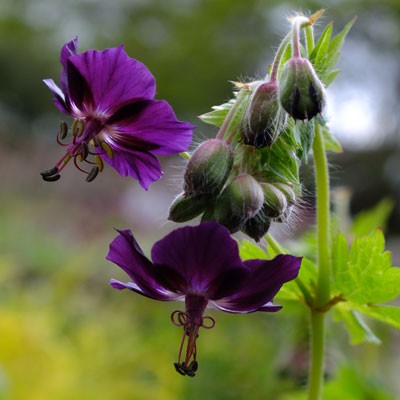
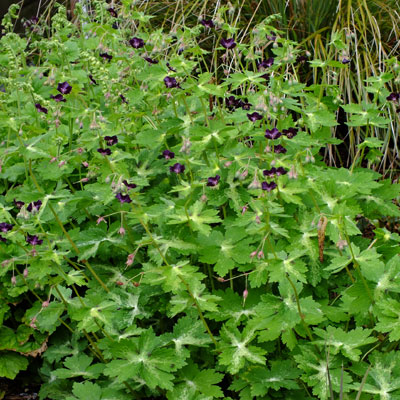
Potsize - 1L
Handsome foliage especially in Spring and Autumn when the hearts of the leaves are cool cream, gradually mottling out towards the edge. The deeply incised leaves are further decorated by strong black spots at the deepest points of the lobes. 50cm. Flowers are silvery purple, highly reflexed, with pink tipped anthers. They are produced over a long period from April to July. Easy and rewarding. Introduced by Coen Jansen. Discount of 25p per plant for quantities of 3 or overLinks
Geranium Compared
Geranium in the Garden
Botanical Style Photographs
-


Pot size - 1L
Soft mauvy-blue flowers with a grey ring make this an unusual, rarely offered colour break for a G.phaeum. Good leafy clumps of unblotched fresh green leaves make excellent Spring foils to other plants in partial shade. Flowering in late April and May these pretty phaeums provide a valuable nectar source fro early insects. 60-75cm fusion_separator style_type="single solid" hide_on_mobile="small-visibility,medium-visibility,large-visibility" class="" id="" sep_color="" top_margin="" bottom_margin="" border_size="" icon="" icon_circle="" icon_circle_color="" width="" alignment="center"][/fusion_separator]Links
Geranium Compared
Geranium in the Garden
Botanical Style Photographs
-
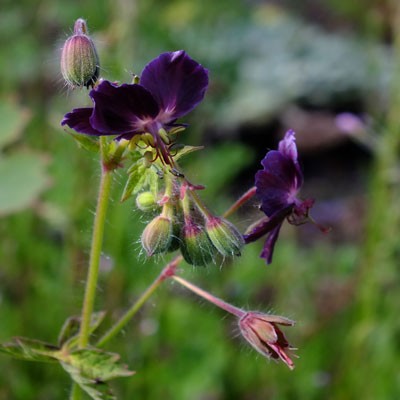

Potsize - 1L
Golden Spring foliage becomes suffused with green and is marbled with a maroon, roughly heart-shaped ring at the depths of the lobes. The flowers are the deepest, richest royal purple. Like all the phaeums it positively thrives in dry shade, though the yellow tones of the leaves may be less strident. A chance seedling found by Piet Oudolf. Discount of 25p per plant for quantities of 3 or overLinks
Geranium Compared
Geranium in the Garden
Botanical Style Photographs
-

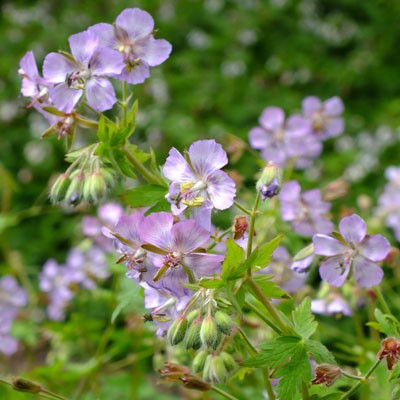
Potsize - 1L
Geranium phaeum var. lividum 'Joan Baker'. The original large flowered form of Geranium phaeum var. lividum was collected on an Alpine Garden Society tour of the dolomites by Bill Baker. Subsequently it was propagated by Axletree Nursery and an attractive pale lilac seedling was selected and named after Bill's wife Joan. Geranium phaeum var. lividum 'Joan Baker' is a robust geranium and grows strongly to 90cm, even in quite dry shade, making a very useful plant indeed.Discount of 25p per plant for quantities of 3 or overLinks
Geranium Compared
Geranium in the Garden
Botanical Style Photographs
-
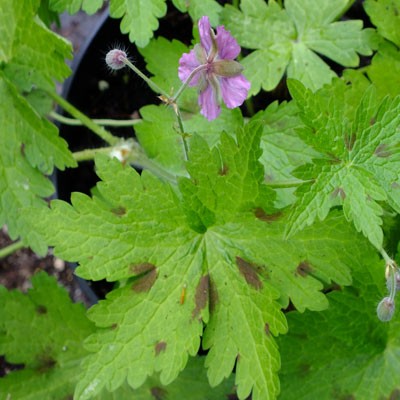
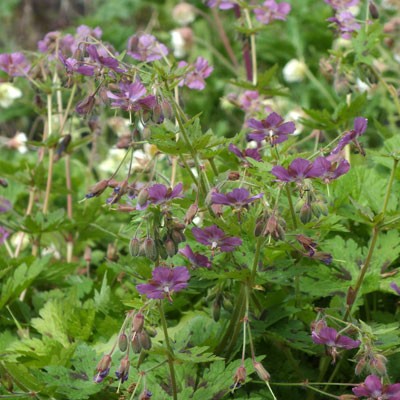
Potsize - 1L
A dusky pink spring flowering Geranium. Typical of its parents, G.phaeum and G.reflexum, it has sprays of long-nosed, slightly reflexed petaled flowers with a white eye and a ring of smoky blue eye-liner. Generous clumps of large palmate and lobed leaves are handsomely marked with strong maroon blotches and stand well in shade, even if dry. Even better is the lovely golden hue the leaves take on in early Spring before greening up later. Really brightens up a shady corner. Originated in the French nursery of its namesake. 45cm tall, spreading indefinitely. Selected by Madame Claudine Dupont. Discount of 25p per plant for quantities of 3 or overLinks
Geranium Compared
Geranium in the Garden
Botanical Style Photographs
-


Potsize - 1L
A fitting name for this lovely Geum. It has 5 rows of frilly petticoat-like petals in a warm soft yellow, all suffused with peach. The centre of each flower has a big boss of yellow stamens tipped with brown anthers all ringed around with the red styles in the middle. Flip the flower over and you find it is washed over in a lovely apricot shade with a dark red calyx and stem. All in all its enough to get you grabbing your skirt and bursting into song. Discount of 25p per plant for quantities of 3 or overLinks
Geum Varieties Compared
Botanical Style Photographs
-
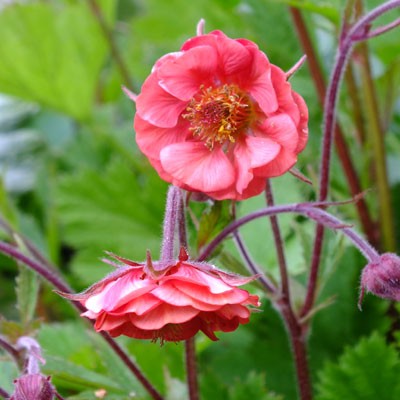

Potsize - 1L
I think this is a slow burner rather than a red hot Latin lover, but it's certainly a Geum to fall in love with. Geum 'Flames of Passion' is relatively short and neat at a foot high. The flowers are 2cm across and look down in a rather coy fashion. They are strawberry pink, slightly ruffled with 3 rows of petals and a charming yellow centre with a green eye. The dark maroon buds and stems round off the effect nicely. So if you are feeling coy yourself, perhaps it's time to give passion a try. Discount of 25p per plant for quantities of 3 or overLinks
Geum Varieties Compared
Botanical Style Photographs
-

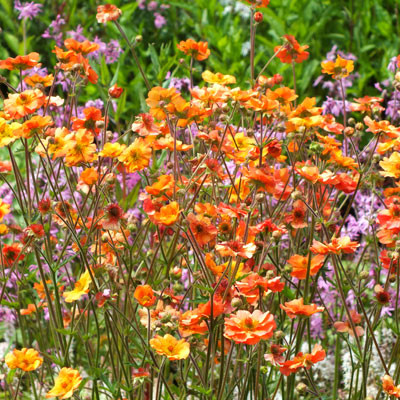
Potsize - 1L
Introduced by Hardy's in 2010, this Geum has built up a great reputation for reliability and impact. It is a sterile hybrid that will hold its zingy semi double orange flowers on stems up to 90cm tall and keep on producing them over an extended season. The flowers can vary in shade from a rich orange back towards a more mellow shade. From a distance it reminds us somewhat of Geum 'Hilltop Beacon' but the growth habit is much more upright and tighter packed. Discount of 25p per plant for quantities of 3 or overLinks
Geum Varieties Compared
Botanical Style Photographs
-
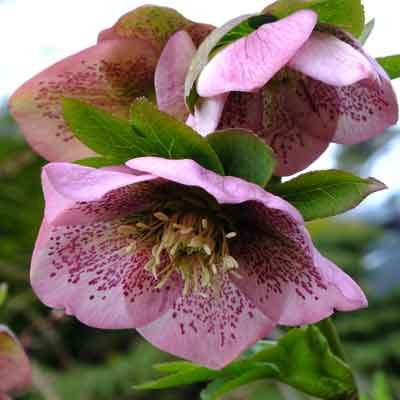

Potsize - 2Ldeep
Helleborus orientalis (Lenten Rose). Seed grown stock grown from our own seed, harvested from a wide selection of choice varieties collected over the last 20 years. They could be single, anemone centred or double in any colour. Pictures show a sample of the plants we collect seed from. These are unflowered plants. As they flower we will offer them as coloured varieties under the specified colour products. If you are looking for a particular colour that is not listed just ask and well see what we can do. Hellebores are so welcome as they bloom soon after Christmas at a time when flowers are so scarce. They come in such a wonderful variety of colour; whites through to pinks and blue-black purples, with some in shades of green and yellow. Many are beautifully spotted inside, but no two are ever identical. Nowadays there are a bewildering array of doubles to add to the mix. Anyone taking the time to stop and lift up a bloom is always well rewarded. Discount of 25p per plant when you buy 3 or more of any HelleboreLinks
Hellebore Gallery
-
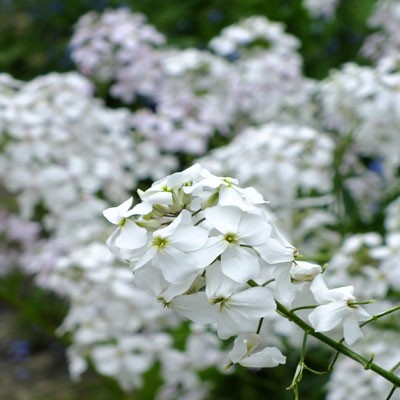
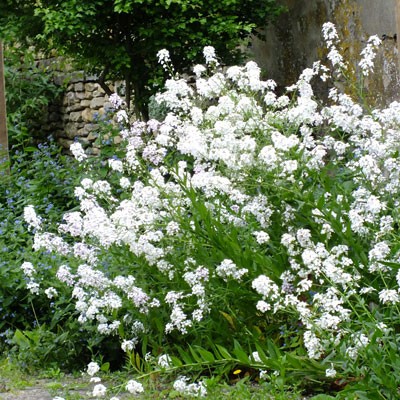
Potsize - 9cm
Dame's Violet, Sweet Rocket. Tall slender stems, 100 to 120cm, with 4 petalled flowers. Heads of highly perfumed flowers reminiscent of willowy stocks. Much loved by pollinating insects. An old Cottage Garden favourite. Short lived, but good for naturalising in damp, shady or grassy places. Discount of 25p per plant for quantities of 3 or over -
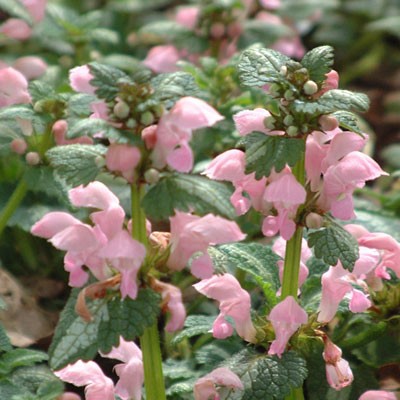
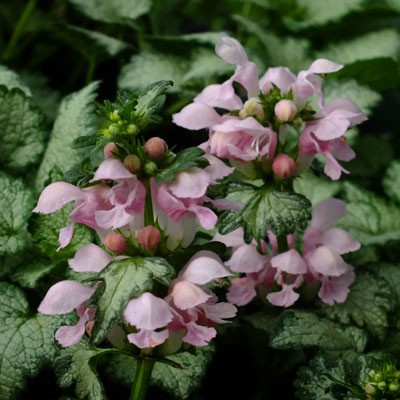
Potsize - 1L
Lamium maculatum 'Pink Pewter'. Just the plant to bring a bit of life into a troublesome dry spot in the garden with its easy habit and lovely richly silvered foliage. Flowers are a rich pink. Useful for ground cover in a wide range of soil and light conditions, growing in all but the wettest conditions and excelling in dry shade .The silvering on the leaves of these plants is caused by air filled blisters just below the surface.Discount of 25p per plant for quantities of 3 or over -

Potsize - 1L
Lamium orvala 'Alba'. This is the pure white flowered form of this stately deadnettle. Rather than the usual ruddy pinks of the species, the dragon-mouth flowers are clean white, shading a little green from the leaves. The leaves and stems also lack the pink pigments giving the whole plant a greener, cleaner look than the species. Non invasive clumper for a nice leafy spot in moist shade. 30-45cm. Thought to have occurred in the Betws y Coed garden of E.C.Buxton.Discount of 25p per plant for quantities of 3 or over -


Potsize - 1L
Lathyrus vernus (spring vetchling) is a beautiful little treasure for the spring garden that is both dainty and robust Dense lush foliage makes a 30 cm high hummock which is covered with many small pea flowers in shades of pink, fading blue. 30cm. WIll grow in a wide range of conditions, but happiest in a little moist shade. Thrives on our heavy clay. There are a variety of colour variants, some of which we offer seperately. Discount of 25p per plant for quantities of 3 or overLinks
Botanical Style Photographs
-
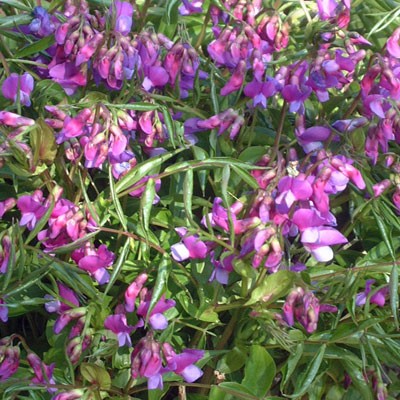

Potsize - 1L
Lathyrus vernus (purple-flowered) - Spring Vetchling. Lathyrus vernus (spring vetchling) is a beautiful little treasure for the spring garden that is both dainty and robust Dense lush foliage makes a 30 cm high hummock which is covered with many small pea flowers in shades of pink, fading blue. 30cm. WIll grow in a wide range of conditions, but happiest in a little moist shade. Thrives on our heavy clay. There are a variety of colour variants, some of which we offer seperately. Discount of 25p per plant for quantities of 3 or overLinks
Botanical Style Photographs
-
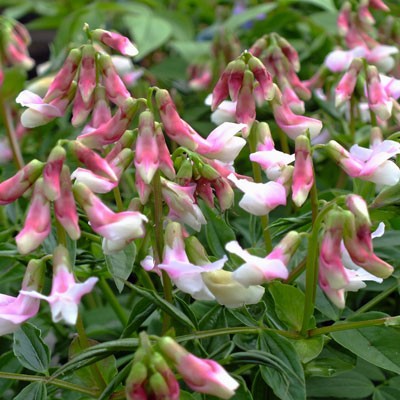

Potsize - 1L
Lathyrus vernus 'Alboroseus' - Spring Vetchling. Lathyrus vernus (spring vetchling) is a beautiful little treasure for the spring garden that is both dainty and robust Dense lush foliage makes a 30 cm high hummock which is covered with many small pea flowers. In this variety the flowers are two-toned pink and white with a rosy red base to each one. 30cm. WIll grow in a wide range of conditions, but happiest in a little moist shade. Thrives on our heavy clay. There are a variety of colour variants, some of which we offer seperately. Discount of 25p per plant for quantities of 3 or overLinks
Botanical Style Photographs
-
 Lysimachia punctata 'Alexander'. Young shoots emerge in spring an eye catching shrimpy pink. As they mature they become cream and green variegated. From June to September it produces heavily crowded stems of a mass of clear yellow flowers. 75cm 2'6''. A very reliable plant for planting in a moist soil. Will run, but not to the extent of the green species.Discount of 25p per plant for quantities of 3 or over
Lysimachia punctata 'Alexander'. Young shoots emerge in spring an eye catching shrimpy pink. As they mature they become cream and green variegated. From June to September it produces heavily crowded stems of a mass of clear yellow flowers. 75cm 2'6''. A very reliable plant for planting in a moist soil. Will run, but not to the extent of the green species.Discount of 25p per plant for quantities of 3 or overLoosestrifes compared
-
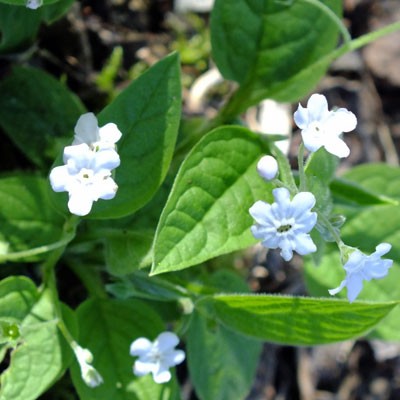

Potsize - 1L
This is the pure white form of Blue Eyed Mary. Much more of a creeper than its cousin, cappadocica and earlier to start flowering in the year. Omphalodes verna 'Alba' will spread quite freely in any cool leafy soil that is not too wet producing a wide mat of rich green foliage dotted here and there withpur white flowers. Very good to bring a sparkle of white into a dark corner. A lovely creeping species form Eastern Europe. Grows best in bright shade in humus rich soil, but relatively adaptable.Discount of 25p per plant for quantities of 3 or overLinks
Botanical Style Photographs
-


Potsize - 1L
Polemonium reptans 'Stairway to Heaven'. Bright creamy margined fern-like foliage that emerges in Spring strongly pink tinged, remaining pink edged for some time. Flowers come later and are a clear pale sky blue produced in a long succession on lax stems. A most attractive and stable variegated Jacobs Ladder. New introduction. Discount of 25p per plant for quantities of 3 or overLinks
Polemonium Compared
-
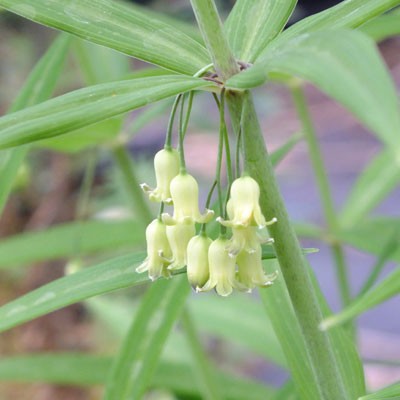
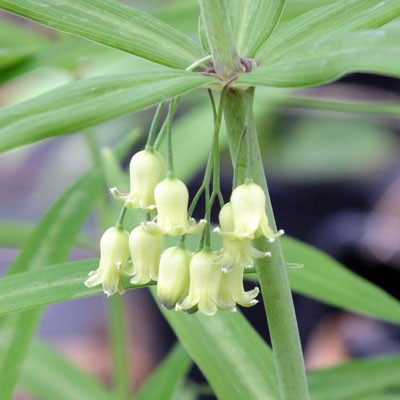
Potsize - 1L
A delicate unusual Solomon's Seal discovered in Yunnan in China where it grows wild in rock crevices in full sun. It produces low arching stems, rarely more than 15 inches high, clothed with elegant whorls of narrow lanceolate leaves with unusual cirrose leaf tips. Cirrose means that the apexes of the leaf blades are elongated and coiled. This property arose as an aide to supporting itself as it clambers up through undergrowth. In late Spring 2-8 flowers are produced in the upper leaf axils, followed by by coral-red fleshy fruits Grow it in cool, humus-rich well drained soil. It is rhizomatous and if you want to grow it from seed, the seed has a double dormancy.Links
Botanical Style Photographs
-
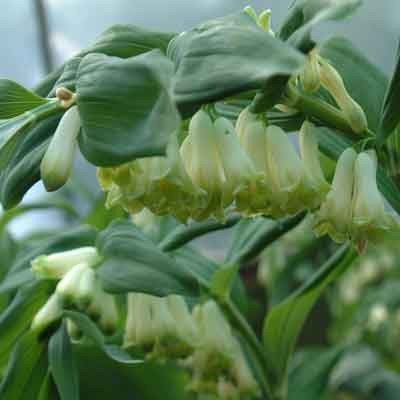

Potsize - 1L
Polygonatum x hybridum (Polygonatum multiflorum) is beautiful in late spring when the forest of arching stems are adorned with the evenly paired leaves above and hung with clusters of dainty creamy white, green-lipped bells below. 60cm; spreading. A plant of great charm for any cool sunless spot. Great for the bumblebees early in the season. Polygonatum x hybridum (P. multiflorum x P.odoratum) is a variable hybrid between two species native to BritainDiscount of 25p per plant for quantities of 3 or overLinks
Botanical Style Photographs
-
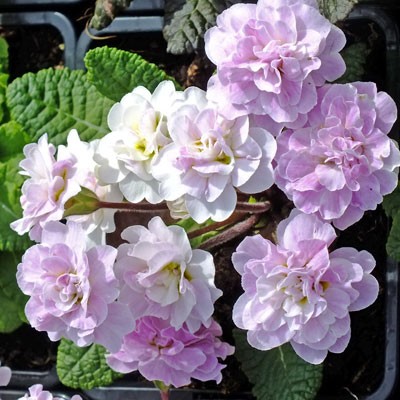

Potsize - 1L
Delightful frilly double primroses open creamy white and quickly develop a suffused fleckled pink glow which is strongest on the outermost petals. The central petals have a hint of lemon at the base. As it is sterile it flowers over a v ery long seasonn from late Autumn into early Summer. A sweet little poppet.Discount of 25p per plant for quantities 3 or over or for any 10 from the 'Higly Bred Primula' categoryLinks
Primula Compared
-


Potsize - 1L
A new range of primula hybrids that combine a compact growth habit with excellent sized double flowers produced from February right on through to Summer. The belarina series has been bred for their ability to go on and on flowering. 12x20cm. Primula Belarina Amethyst Ice has bright mauve purple flowers with a thin white edge.Discount of 25p per plant for quantities 3 or over or for any 10 from the 'Higly Bred Primula' categoryLinks
Primula Compared
-
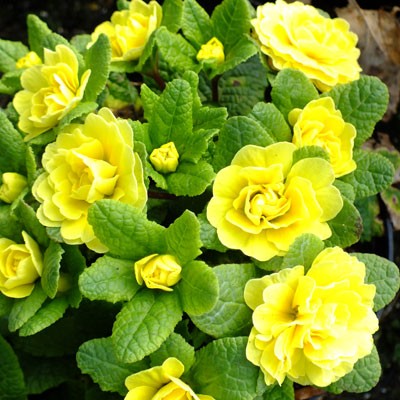
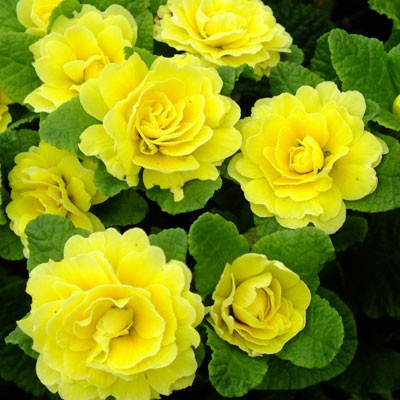
Potsize - 1L
Primula Belarina Butter Yellow. A new range of primula hybrids that combine a compact growth habit with excellent sized double flowers produced from February right on through to Summer. The belarina series has been bred for their ability to go on and on flowering. 12x20cm. Butter Yellow has, most surprisingly, Buttery-yellow flowers with a collar of leafy bracts.Discount of 25p per plant for quantities 3 or over or for any 10 from the 'Higly Bred Primula' categoryLinks
Primula Compared
-
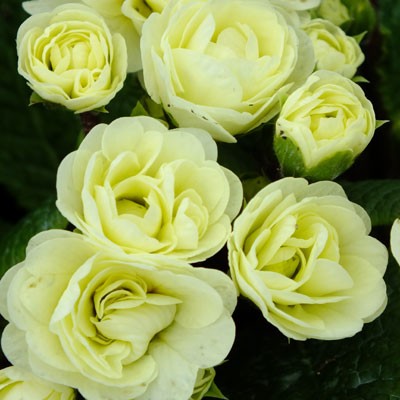
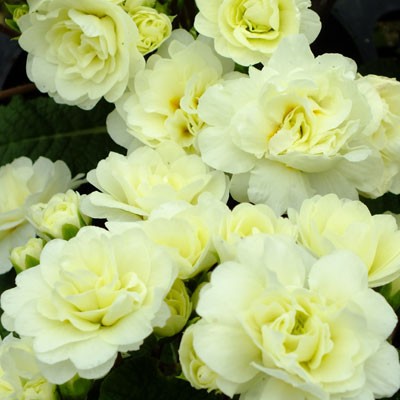
Potsize - 1L
Primula Belarina Cream. A new range of primula hybrids that combine a compact growth habit with excellent sized double flowers produced from February right on through to Summer. The belarina series has been bred for their ability to go on and on flowering. 12x20cm. 12x20cm. This form is a delicate shade of cream shaded lemon at centre with the most delightful complex scent.Discount of 25p per plant for quantities 3 or over or for any 10 from the 'Higly Bred Primula' categoryLinks
Primula Compared
-
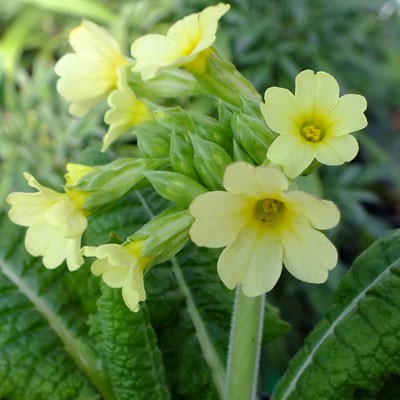
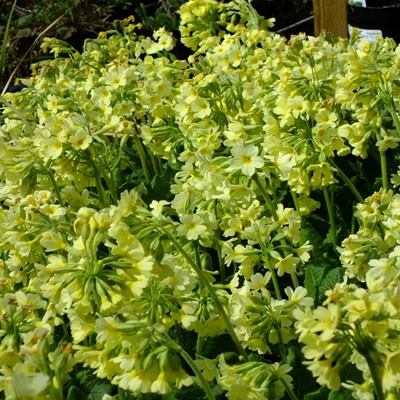
- Bee Friendly
- RHS AGM
Potsize - 9cm
Primula elatior (Oxlip). The wild form of our native Oxlip. From early spring a rosette of apple green foliage emerges which in april or may sends up stems from 10 to 30cm which are topped with a one sided umbel of short stalked primrose flowers. It was once prolific in eastern England from London to Cambridge and into Norfolk, where it was synonymous with acient woodland coppices and grew in large numbers, replacing the common primrose. It is easily grown in heavy rich soils, particularly over chalk, in shade or partial shade which do not dry out in summer. Discount of 30p per plant for quantities of 3 -9, 50p for 10 or overLinks
Primula Compared

















































